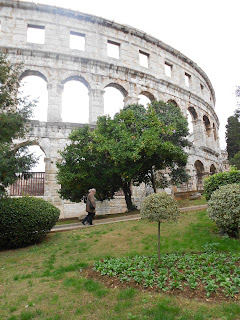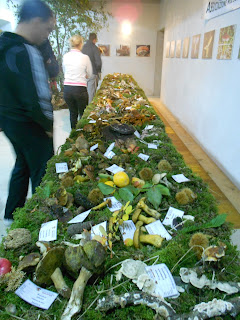Croatia has some distinctly positive features.
One of them is the climate!
This first shot shows the amazing view right out my sister's front door. She and her husband have purchased a stone house in Istria and go twice a year to relax and enjoy the amazing things Croatia has to offer.
 Along the flagstone terrace, there is an outdoor fireplace which can be used for most of the year. Just steps from the front door, it was a lovely place to sip tea in the morning sunshine. It is such a relaxing spot! Rosemary, roses, almond trees - treats for every sense, all add to the ambiance.
Along the flagstone terrace, there is an outdoor fireplace which can be used for most of the year. Just steps from the front door, it was a lovely place to sip tea in the morning sunshine. It is such a relaxing spot! Rosemary, roses, almond trees - treats for every sense, all add to the ambiance.
One highlight of the day was always a stroll to the nearest village, along a stone fence-lined curving road. In the spring, the acacias are in full sweet bloom, perfuming the air with their aroma. In the fall, the views of the multi-coloured leaves through the trees, rolling hills, and homes nestled in copses of brightly glazed forest were among the sweet sights.
This shot gives an idea of the rolling hills and beautiful roadways in the area. Tiny fields of barley, vegetables, and vineyards dot the route. To a prairie farm girl, the fields looked like play plots!
In all the time I was visiting this charming area, we were never more than 50 miles from 'home sweet home', my sister's delightful house. There was so much to see and do every day, we were always busy - but as there is a surprising adventure around every corner, we never had to venture far to find it!
One of them is the climate!
This first shot shows the amazing view right out my sister's front door. She and her husband have purchased a stone house in Istria and go twice a year to relax and enjoy the amazing things Croatia has to offer.
 Along the flagstone terrace, there is an outdoor fireplace which can be used for most of the year. Just steps from the front door, it was a lovely place to sip tea in the morning sunshine. It is such a relaxing spot! Rosemary, roses, almond trees - treats for every sense, all add to the ambiance.
Along the flagstone terrace, there is an outdoor fireplace which can be used for most of the year. Just steps from the front door, it was a lovely place to sip tea in the morning sunshine. It is such a relaxing spot! Rosemary, roses, almond trees - treats for every sense, all add to the ambiance.One highlight of the day was always a stroll to the nearest village, along a stone fence-lined curving road. In the spring, the acacias are in full sweet bloom, perfuming the air with their aroma. In the fall, the views of the multi-coloured leaves through the trees, rolling hills, and homes nestled in copses of brightly glazed forest were among the sweet sights.
This shot gives an idea of the rolling hills and beautiful roadways in the area. Tiny fields of barley, vegetables, and vineyards dot the route. To a prairie farm girl, the fields looked like play plots!
In all the time I was visiting this charming area, we were never more than 50 miles from 'home sweet home', my sister's delightful house. There was so much to see and do every day, we were always busy - but as there is a surprising adventure around every corner, we never had to venture far to find it!













































